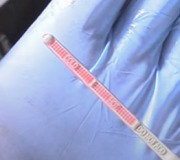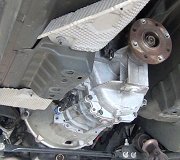The automatic transmission is a 4-speed unit with electronic control of gear selection, shift quality and torque converter lock-up. Selections on the gear selector lever assembly are transmitted to the automatic transmission by a gear selector cable. A gear position switch on the automatic transmission transmits the gear selection to an Electronic Automatic Transmission Electronic Control Unit (EAT ECU), which outputs the appropriate control signals to an electro-hydraulic valve block in the automatic transmission. A mode switch enables the driver to change the control mode of the EAT ECU. The EAT ECU operates warning lamps in the instrument cluster to indicate the control mode and system status.
The automatic transmission features a pressure lubrication system and is cooled by pumping the lubricant through an engine oil cooler.
On 2003 vehicles, the ZF4HP24 transmission was introduced for use with the 4.6L V8 engine. This transmission is required to accommodate the increased power output of the larger engine. The ZF4HP22 transmission remains in use on vehicles with 4.0L V8 engines.
Both transmission units are of similar construction, with the ZF4HP24 unit being 0.6" (15 mm) longer than the ZF4HP22 unit to accommodate a larger transmission fluid pump. The operation of both transmission units is the same.
The gear change points of an electronically/hydraulically controlled transmission are more precise and consistent. With mechanical/hydraulic control there is a greater tolerance band regarding the gear change points because of the nature of mechanical components, which are influenced by conditions such as temperature and component wear.
The load on the transmission can be reduced by introducing engine intervention when the automatic transmission changes gear. Rather than operating independently of the engine management system, the transmission EAT ECU is capable of communicating with the Engine Control Module (ECM).
Sunday, June 27th, 2010 AT 4:38 AM


